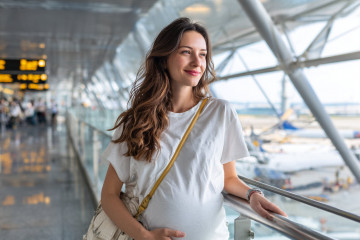Backache after a long car ride? Sore neck from trying to sleep on a plane? Try these tips before the next time you head out of town.
I love taking vacations, but travel has an uncanny way of making me feel old. I inevitably pull a muscle trying to lift my bag into the plane’s overhead bin. My lower back aches during long car rides. My neck throbs after a short airplane nap.
It’s not surprising that travel causes pain and, sometimes, injury. “You’re out of your norm, you’re changing your patterns,” said Dr. D.J. Kennedy, a physical medicine and rehabilitation physician at Vanderbilt University Medical Center. You’re doing things like pulling a 30-pound suitcase for what feels like six miles as you sprint to catch your connecting flight, which is probably not something your body has trained for.
With summer travel approaching prepandemic levels in the United States, I’m sure I’m not alone in experiencing — and wondering what can be done to ease — travel-induced aches and pains. So for this week’s newsletter, in part because I have a cross-country flight in a few days, I talked to a physical therapist and two physicians to get advice.
Make travel plans with your body in mind
When you’re planning a vacation, keep your body’s strengths and limitations in mind, Dr. Kennedy suggested. If sitting in a car for long periods tends to hurt your back, a weeklong road trip might not be your best option.
That said, if you really want to take the trip that might make your body unhappy, you can take steps to prepare for it in advance. If you have arthritis in your knee and walking is painful, you can still go on a walking tour, but you might want to see a physical therapist or physical medicine doctor in the months leading up to the trip to improve your range of motion and endurance, Dr. Kennedy said. Or, he added, you might think about getting a shot to reduce swelling and pain. Be sure to bring any doctor-recommended pain medications with you in case you need them, too, he said.
Limit the weight you must bear
When it comes to handling luggage, the best approach is to pack lightly so your bags aren’t heavy. But that’s simply not possible for some people (including me). Thankfully, there are ways to make heavy luggage more manageable.
Dr. Kennedy said that roller bags are less likely to cause injury and pain than bags you must carry by hand or on your shoulder. He prefers bags that move on four wheels rather than two, because moving them requires less effort. The big pushcarts you can rent from the airport can also be helpful for moving luggage, he said.
If you need to carry a bag on your body, a backpack is the best option, said Dr. Deborah Venesy, a physician in the Cleveland Clinic’s Center for Spine Health in Ohio, and she said you should use both straps to distribute the weight evenly. Colleen Louw, a physical therapist based in Iowa and a spokeswoman for the American Physical Therapy Association, added that backpacks should hang evenly in the middle of the back — not down against the low back — and that straps should be adjusted to make it easy to take the backpack on and off.
Don’t hesitate to ask for help if you struggle to lift your luggage, Dr. Kennedy said. (He is a former competitive powerlifter, but said he has a shoulder injury and often asks for help lifting his bags into the plane’s overhead compartment.)
If sitting causes pain, take movement and stretching breaks
An hour or so into every car or plane ride, the side of my back starts aching, and that’s in part because bodies aren’t meant to stay stationary. “Movement is essential to keep blood flowing to your muscles and joints to help prevent stiffness and pain,” Ms. Louw explained. Ideally, you’ll want to stand up and walk around at least once every hour if you’re feeling pain, Dr. Kennedy advised. If you have trouble remembering to do this, set a timer or drink lots of water so you need frequent bathroom breaks, he suggested. (Dr. Venesy said she prefers aisle seats so she can get up regularly.)
As for how to sit, Ms. Louw said that sitting upright, or with a slight recline, is generally the best position for the spine. Dr. Venesy added that rolling up a sweatshirt or fleece and resting it behind your lower back could also provide pain-relieving lumbar support.
Stretching can also be useful. One good stretch to do while sitting is a spine twist, where you put both hands on one leg and gently twist your upper body in the same direction, then repeat on the other side, Dr. Venesy said. A good seated stretch for the low back and hips is a figure four stretch, where you rest your right heel on your left knee and lean forward, and vice versa, she added. Dr. Kennedy said that it may feel good to stand up and do a slight back bend, too. (If you’re in pain from standing for a long time, the opposite could ease your pain — leaning into a forward fold, he said.)
If you experience leg cramps while sitting, try pumping your ankles — alternately pointing and then flexing your feet — with your knees bent and extended, Ms. Louw suggested.
Prevent neck pain by reading or watching tablets at eye level and using a neck pillow
If you’re anything like me, you look down a lot during flights or as a car passenger — at your phone, a tablet or a book. But this position can cause neck pain, Dr. Kennedy said. It’s far better to bring things closer to eye level. Some airplanes now have devices that allow you to hang your phone or tablet on the back of the seat in front of you, he said, and you can also buy accessories that will do this for you (or even fashion one out of a sickness bag).
If you think you’ll doze off in the plane or car, you may also want to invest in a neck pillow. Dr. Kennedy prefers designs that are thinner in the back than on the sides, because they don’t pitch the head forward too much when you lean against the seat.
I’m not going to be able to put all these suggestions into practice for my upcoming trip — I’m sure my suitcase will be just under the maximum weight limit, as usual — but I’ll certainly make some changes to my travel habits.



